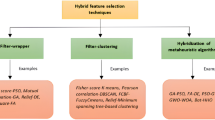Abstract
Nowadays, phishing attacks have grown rapidly, and there is an urgent need to introduce a suitable detection method that has the ability to detect different types of phishing attacks. This paper investigates the capability to use bio-inspired meta-heuristic algorithms to improve the performance of the detection engine for phishing attacks by reducing the number of features. This improvement was practiced by investigating the effectiveness of five meta-heuristic algorithms: Particle Swarm Optimization (PSO), Firefly Optimization Algorithm (FFA), Multi-Verse Optimizer (MVO), Moth-Flame Optimization algorithm (MFO), and BAT optimization algorithm, to select the relevant features that could be affected directly by different types of phishing attacks. The suggested detection model was tested and evaluated using four benchmark phishing attack datasets, and the Apache Spark-based decision tree algorithm was selected as a detection engine. The conducted experiments have demonstrated that the Spark-based MVO algorithm achieved the highest detection rate for detecting different types of phishing attacks within four phishing attack datasets. Moreover, the suggested detection model was able to reduce effectively the feature space, which could enhance the computational efficiency.






Similar content being viewed by others
Data availability
Manuscript has no associated data.
References
Abass, I.A.M., et al.: Social engineering threat and defense: a literature survey. J. Inf. Secur. 9(04), 257 (2018)
Salahdine, F., Kaabouch, N.: Social engineering attacks: a survey. Future Internet 11(4), 89 (2019)
Sadiq, A., Anwar, M., Butt, R.A., Masud, F., Shahzad, M.K., Naseem, S., Younas, M.: A review of phishing attacks and countermeasures for internet of things-based smart business applications in industry 4.0. Hum. Behav. Emerg. Technol. 3(5), 854–864 (2021)
Basit, A., Zafar, M., Liu, X., Javed, A.R., Jalil, Z., Kifayat, K.: A comprehensive survey of ai-enabled phishing attacks detection techniques. Telecommun. Syst. 76(1), 139–154 (2021)
Oest, A., Zhang, P., Wardman, B., Nunes, E., Burgis, J., Zand, A., Thomas, K., DoupÃÂ, A., Ahn, G.J.: Sunrise to sunset: analyzing the end-to-end life cycle and effectiveness of phishing attacks at scale. In: 29th \(\{\)USENIX\(\}\) Security Symposium (\(\{\)USENIX\(\}\) Security 20) (2020)
Penmatsa, R.K.V., Kakarlapudi, P.: Web phishing detection: feature selection using rough sets and ant colony optimisation. Int. J. Intell. Syst. Design Comput. 2(2), 102–113 (2018)
Tang, L., Mahmoud, Q.H.: A survey of machine learning-based solutions for phishing website detection. Mach. Learn. Knowl. Extr. 3(3), 672–694 (2021)
Gupta, B.B., Tewari, A., Jain, A.K., Agrawal, D.P.: Fighting against phishing attacks: state of the art and future challenges. Neural Comput. Appl. 28(12), 3629–3654 (2017)
Alanezi, M.: Phishing detection methods: a review. (2021)
Gutierrez, C.N., Kim, T., Della Corte, R., Avery, J., Goldwasser, D., Cinque, M., Bagchi, S.: Learning from the ones that got away: detecting new forms of phishing attacks. IEEE Trans. Dependable Secure Comput. 15(6), 988–1001 (2018)
Drury, V., Lux, L., Meyer, U.: Dating phish: an analysis of the life cycles of phishing attacks and campaigns. In: Proceedings of the 17th International Conference on Availability, Reliability and Security, pp. 1–11 (2022)
Almseidin, M., Alzubi, M., Alkasassbeh, M., Kovacs, S.: Applying intrusion detection algorithms on the KDD-99 dataset. Prod. Syst. Inf. Eng. 8, 51–67 (2019)
Almseidin, M., Al-Sawwa, J.,Alkasassbeh, M.: Anomaly-based intrusion detection system using fuzzy logic. In: 2021 International Conference on Information Technology (ICIT), pp. 290–295. IEEE (2021)
Almseidin, M., Al-Sawwa, J., Alkasassbeh, M.: Generating a benchmark cyber multi-step attacks dataset for intrusion detection. J. Intell. Fuzzy Syst. 43(3), 3679–3694 (2022)
Devika, G., Karegowda, A.G.: Bio-inspired optimization: Algorithm, analysis and scope of application. In Swarm Intelligence-Recent Advances and Current Applications. IntechOpen (2023)
Darvishpoor, S., Darvishpour, A., Escarcega, M., Hassanalian, M.: Nature-inspired algorithms from oceans to space: a comprehensive review of heuristic and meta-heuristic optimization algorithms and their potential applications in drones. Drones 7(7), 427 (2023)
Yang, X.-S.: Nature-inspired optimization algorithms: challenges and open problems. J. Comput. Sci. 46, 101104 (2020)
Kennedy, J., Eberhart, R.: Particle swarm optimization. In: Proceedings of ICNN’95-international conference on neural networks, vol. 4, pp. 1942–1948 (1995)
Mirjalili, S., Mirjalili, S.M., Hatamlou, A.: Multi-verse optimizer: a nature-inspired algorithm for global optimization. Neural Comput. Appl. 27, 495–513 (2016)
Mirjalili, S., Lewis, A.: The whale optimization algorithm. Adv. Eng. Softw. 95, 51–67 (2016)
Alsariera, Y.A., Balogun, A.O., Adeyemo, V.E., Tarawneh, O.H., Mojeed, H.A.: Intelligent tree-based ensemble approaches for phishing website detection. J. Eng. Sci. Technol. 17, 563–582 (2022)
Aljofey, A., Jiang, Q., Rasool, A., Chen, H., Liu, W., Qiang, Q., Wang, Y.: An effective detection approach for phishing websites using URL and HTML features. Sci. Rep. 12(1), 1–19 (2022)
Kalabarige, L.R., Rao, R.S., Abraham, A., Gabralla, L.A.: Multilayer stacked ensemble learning model to detect phishing websites. IEEE Access 10, 79543–79552 (2022)
Barraclough, P.A., Fehringer, G., Woodward, J.: Intelligent cyber-phishing detection for online. Comput. Secur. 104, 102123 (2021)
Sabahno, M., Safara, F.: ISHO: improved spotted hyena optimization algorithm for phishing website detection. Multimedia Tools Appl. 81(24), 34677–34696 (2022)
Odeh, A., Keshta, I., Abdelfattah, E.: Phiboost-a novel phishing detection model using adaptive boosting approach. Jordan. J. Comput. Inf. Technol. 7(01), 1 (2021)
Adeyemo, V.E., Balogun, A.O., Mojeed, H.A., Akande, N.O., Adewole, K.S.: Ensemble-based logistic model trees for website phishing detection. In: International Conference on Advances in Cyber Security, pp. 627–641. Springer (2021)
Lakshmi, L., Purushotham Reddy, M., Santhaiah, C., Janardhan Reddy, U.: Smart phishing detection in web pages using supervised deep learning classification and optimization technique ADAM. Wirel. Person. Commun. 118(4), 3549–3564 (2021)
Sagnik Anupam and Arpan Kumar Kar: Phishing website detection using support vector machines and nature-inspired optimization algorithms. Telecommun. Syst. 76(1), 17–32 (2021)
Gandotra, E., Gupta, D.: Improving spoofed website detection using machine learning. Cybern. Syst. 52(2), 169–190 (2021)
Lakshmanarao, A., Rao, P.S.P., Krishna, M.B.: Phishing website detection using novel machine learning fusion approach. In: 2021 International Conference on Artificial Intelligence and Smart Systems (ICAIS), pp. 1164–1169. IEEE (2021)
Lakshmi, L., Reddy, M.P., Santhaiah, C., Reddy, U.J.: Smart phishing detection in web pages using supervised deep learning classification and optimization technique adam. Wirel. Pers. Commun. 118(4), 3549–3564 (2021)
Alsariera, Y.A., Adeyemo, V.E., Balogun, A.O., Alazzawi, A.K.: Ai meta-learners and extra-trees algorithm for the detection of phishing websites. IEEE Access 8, 142532–142542 (2020)
Zamir, A., Khan, H.U., Iqbal, T., Yousaf, N., Aslam, F., Anjum, A., Hamdani, M.: Phishing web site detection using diverse machine learning algorithms. Electr. Libr. 38(1), 65–80 (2020)
Yazan Ahmad Alsariera, Victor Elijah Adeyemo, Abdullateef Oluwagbemiga Balogun, and Ammar Kareem Alazzawi. Ai meta-learners and extra-trees algorithm for the detection of phishing websites. IEEE Access, 8:142532–142542, 2020
Mohammad, R.M., Thabtah, F., McCluskey, L.: An assessment of features related to phishing websites using an automated technique. In: 2012 international conference for internet technology and secured transactions, pp. 492–497. IEEE (2012)
Yang, P., Zhao, G., Zeng, P.: Phishing website detection based on multidimensional features driven by deep learning. IEEE Access 7, 15196–15209 (2019)
Ali, W., Ahmed, A.A.: Hybrid intelligent phishing website prediction using deep neural networks with genetic algorithm-based feature selection and weighting. IET Inf. Secur. 13(6), 659–669 (2019)
Chiew, K.L., Tan, C.L., Wong, K., Yong, K.S.C., Tiong, W.K.: A new hybrid ensemble feature selection framework for machine learning-based phishing detection system. Inf. Sci. 484, 153–166 (2019)
Jain, A.K., Gupta, B.B.: Towards detection of phishing websites on client-side using machine learning based approach. Telecommun. Syst. 68(4), 687–700 (2018)
Yang, X.-S.: Firefly algorithms for multimodal optimization. In Stochastic Algorithms: Foundations and Applications: 5th International Symposium, SAGA 2009, Sapporo, Japan, October 26–28, 2009. Proceedings 5, pp. 169–178. Springer (2009)
Kaveh, A., Talatahari, S.: A novel heuristic optimization method: charged system search. Acta Mech. 213(3–4), 267–289 (2010)
Mirjalili, S.: Moth-flame optimization algorithm: a novel nature-inspired heuristic paradigm. Knowl.-Based Syst. 89, 228–249 (2015)
Alweshah, M., Hammouri, A., Alkhalaileh, S., Alzubi, O.: Intrusion detection for the internet of things (IoT) based on the emperor penguin colony optimization algorithm. J. Ambient Intell. Hum. Comput. 14, 1–18 (2022)
Almseidin, M., Al-Sawwa, J., Alkasassbeh, M.: Generating a benchmark cyber multi-step attacks dataset for intrusion detection. J. Intell. Fuzzy Syst. 43, 1–15 (2022)
Gupta, B., Rawat, A., Jain, A., Arora, A., Dhami, N.: Analysis of various decision tree algorithms for classification in data mining. Int. J. Comput. Appl. 163(8), 15–19 (2017)
Tan, C.L.: Phishing dataset for machine learning: feature evaluation. Mendeley Data 1, 2018 (2018)
Mamun, M.S.I., Rathore, M.A., Lashkari, A.H., Stakhanova, N., Ghorbani, A.A.: Detecting malicious urls using lexical analysis. In Network and System Security: 10th International Conference, NSS 2016, Taipei, Taiwan, September 28–30, 2016, Proceedings 10, pp. 467–482. Springer (2016)
Vrbani, G., Fister, I., Podgorelec, V.: Datasets for phishing websites detection. Data Brief 33, 106438 (2020)
Funding
No funds, grants, or other support was received.
Author information
Authors and Affiliations
Contributions
All authors have contributed equally to the work.
Corresponding author
Ethics declarations
Conflict of interest
The authors declare that they have no conflicts of interest.
Ethical approval
Not applicable
Additional information
Publisher's Note
Springer Nature remains neutral with regard to jurisdictional claims in published maps and institutional affiliations.
Rights and permissions
Springer Nature or its licensor (e.g. a society or other partner) holds exclusive rights to this article under a publishing agreement with the author(s) or other rightsholder(s); author self-archiving of the accepted manuscript version of this article is solely governed by the terms of such publishing agreement and applicable law.
About this article
Cite this article
Al-Sawwa, J., Almseidin, M., Alkasassbeh, M. et al. Spark-based multi-verse optimizer as wrapper features selection algorithm for phishing attack challenge. Cluster Comput (2024). https://doi.org/10.1007/s10586-024-04272-2
Received:
Revised:
Accepted:
Published:
DOI: https://doi.org/10.1007/s10586-024-04272-2




